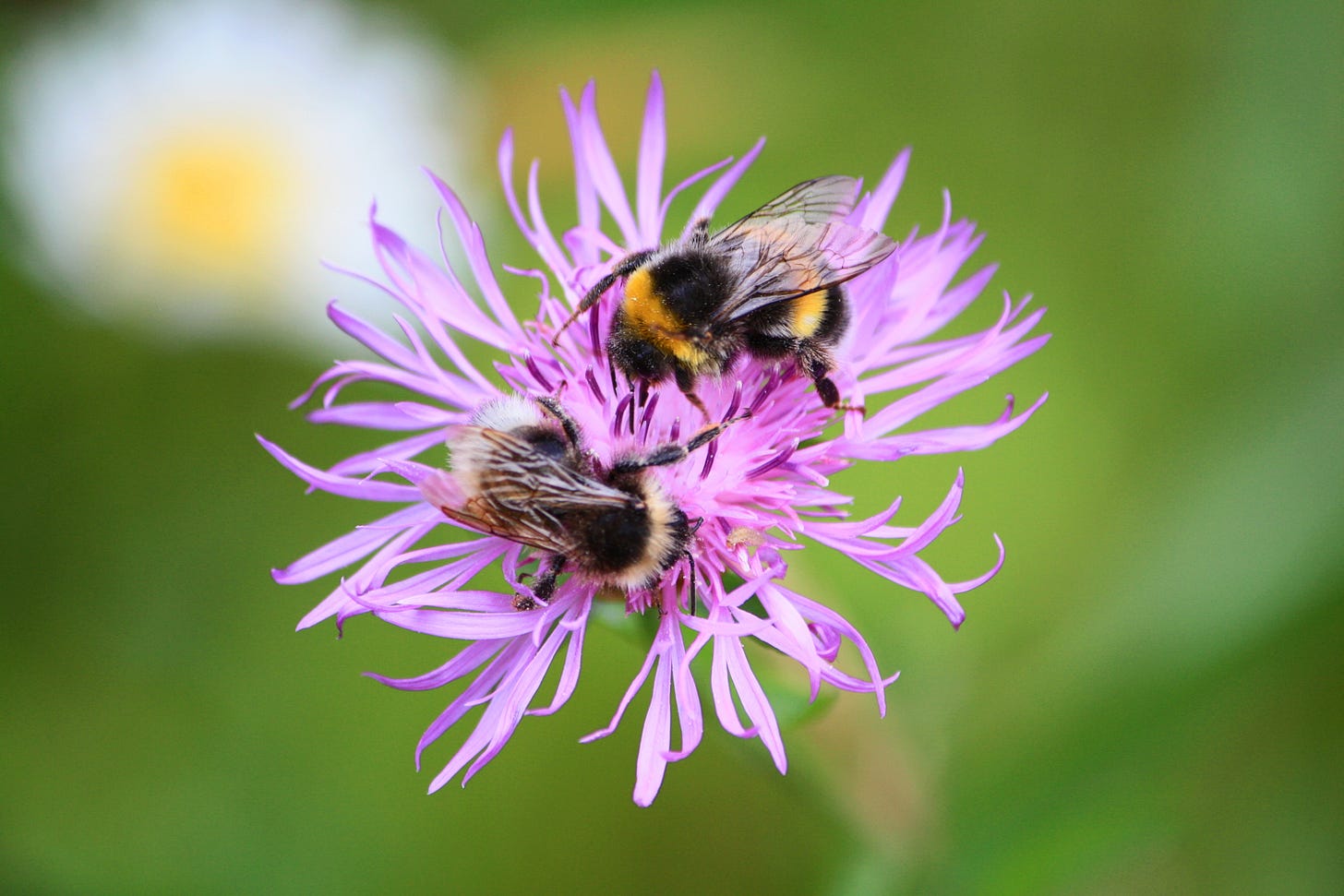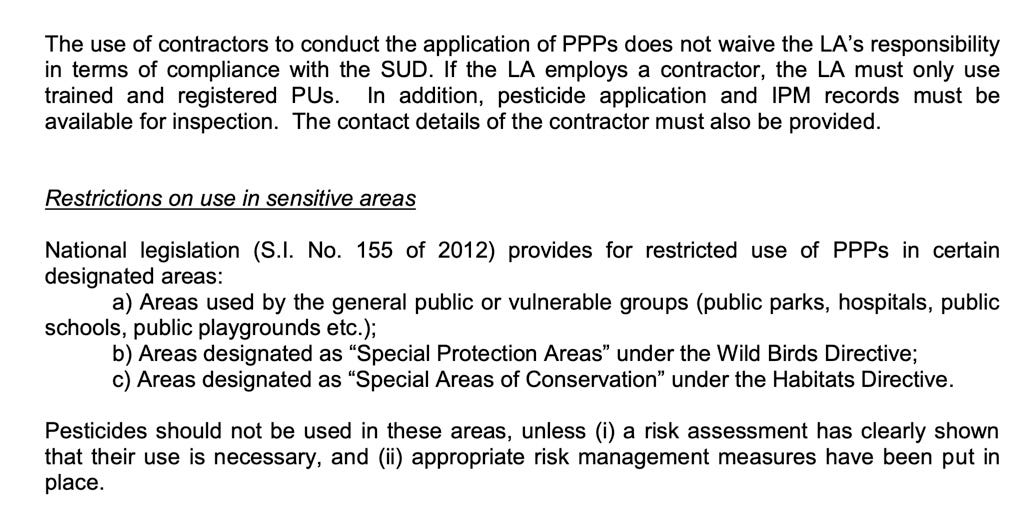Meet the North Cork man petitioning to ban glyphosate
James Walsh says councils and others are already breaking the law by spraying in public spaces

He has nearly 5,000 handwritten signatures, and he’s planning on visiting the Dáil in December to deliver his petition.
James Walsh, originally from East Cork but now living in Churchtown near Mallow, wants to see an all-out ban on spraying glyphosate in public places in Ireland. He’s going to present his petition in the hopes that it will be examined by the Joint Committee on Public Petitions in just over a month.
“In my opinion, glyphosate should be banned everywhere, even in agriculture,” James tells me. ”But definitely in public areas, they shouldn’t be using a single drop.”
James started to become aware of the amount of spraying taking place after the birth of his son, who is now three. He says that once you become aware of the amount of spraying, you can’t unsee it: it’s being done by farmers, local authorities, private individuals and roadside maintenance contractors, all without consultation or quantification of how much is in use and almost always without so much as a warning sign to notify the public that herbicides have been sprayed.
“I’ve only become aware of the amount of spraying since I moved to North Cork,” James says. “The spraying is everywhere: along public roads, playgrounds, streets, squares, outside businesses and restaurants. I’ve also been walking on the Marina over the summer and seen a little girl of maybe three or so actually rolling around on sprayed grass.”
“There are four roads going into my village and if you’re walking or cycling, you have no choice but to pass about a mile of sprayed lane. It’s very dangerous: there are children walking the roads who are forced to step into the sprayed areas when cars pass. Because it takes seven days for the plants to turn brown, they might not even know it’s been sprayed.”
James has an online version of his petition too, but it hasn’t generated as much interest as him doing the footwork has: he’s collected signatures in his area, in local businesses and at Mahon Point Farmer’s Market.
What’s the problem?
Glyphosate is a systemic weedkiller, the active ingredient in Roundup, the world’s most-used herbicide.
Roundup has been in use since the seventies and on paper, the vast majority of regulatory authorities around the world state that glyphosate is safe and virtually non-toxic: in its proprietary form, you can buy it off-the-shelf in garden centres and the European Food Safety Authority lists it as safe.
But in 2015, the WHO’s International Agency for Cancer Research broke rank and listed glyphosate as “probably carcinogenic to humans.” They reached a drastically different conclusion to a US EPA review a year later, they say because they relied on peer-reviewed studies from researchers with no vested interests, while in its 2016 review of glyphosate, the US EPA relied on research commissioned by the chemical companies.
The IARC also factored in levels of exposure associated with occupational exposure to glyphosate, while the US EPA only examined levels that were likely to be regularly ingested: because glyphosate is so widely used in agriculture, it is present in small quantities in many of our foods and most of our bodies.
In fact, since the global introduction of “Roundup-ready” GMO crops that can withstand high doses of the herbicide, glyphosate use in agriculture has increased 15-fold, with GM crops accounting for 56% of global glyphosate use.
In Ireland, 240,000 kgs of glyphosate is used annually on Irish farms, according to the Department of Agriculture, Food and the Marine, and this amounts to about half of Irish usage of the chemical.
The rest is by Local Authorities, Transport Infrastructure Ireland, and a wide variety of other private and public entities involved in land management including golf courses and business campuses.
Indeed, the recent topical application of glyphosate to Japanese Knotweed in the River Bride - stem injection is the recommended treatment because it reduces the release of glyphosate into watercourses, where it is known to be toxic to aquatic life - was actually contracted by the OPW.

Billion-dollar US lawsuits
In the US, occupational exposure is turning out to be a huge headache for Bayer, the chemical company who bought out Roundup manufacturers Monsanto in 2018, shortly before a string of high-profile US lawsuits, beginning with the landmark ruling that school groundskeeper Dewayne Johnson’s cancer was caused by his occupational exposure to Roundup.
A succession of recent American rulings has found against Bayer on appeal, and in favour of claimants saying their cancers have been caused by Roundup and other glyphosate-containing products. US courts are accepting a clear causal link between sustained glyphosate exposure and cancers, specifically non-Hodgkins Lymphoma.
Yet safety data sheets for glyphosate herbicides still say there’s no evidence that the substance is, as the IARC assert, genotoxic and a class 2 carcinogen.
An EU information war
It’s clear that drastic differences in safety information presented in the US and EU for the same substance amount to political differences, not to differences in how a chemical behaves on different landmasses.
In Ireland, a standard response to any questions about glyphosate use to local authorities is that all herbicides are approved by the Department of Agriculture, Food and the Marine, and the European Commission.
In Europe, a review of glyphosate is underway at present: current approval for the herbicide expires in December 2022. The Glyphosate Renewal Group (a consortium of chemical companies including Bayer) has applied for new approval and four EU countries, The Netherlands, France, Hungary and Sweden, are acting as rapporteurs for the review of the chemical’s safety.
There’s no doubt that the IARC classification in 2015 has created global ripples: many EU countries have been instituting restrictions on glyphosate sale or use, or, like Germany, have announced a phased ban over time, giving farmers and amenity workers time to explore alternatives before a national ban comes into effect in 2024.
Many have shied away from full bans: Austria was the first country to pass a law banning glyphosate outright, in 2019, but so far has not enacted it.
This is in no small part due to the undeniable usefulness of the chemical to farmers. When I interviewed Teagasc’s head of Crops and Environment for a podcast episode on agricultural use of glyphosate, he was of the opinion that it is irreplaceable: that Irish farming simply isn’t viable without it.

What is underway in the EU at present is essentially an information war.
Some papers have found that glyphosate disrupts bee gut health. Ask the Glyphosate Renewal Group, though, and they’ll tell you not only that glyphosate is harmless to bees, but also that “Glyphosate has a long history of contributing to the improvement of soil health and soil biodiversity.”
Ask some campaigners, and they’ll tell you that the road to glyphosate re-approval is littered with industry-sponsored research.
A letter to Local Authorities
In the US, the glyphosate court drama is on and in the EU, the glyphosate information wars are in full swing. But here in Ireland, tumbleweed: there’s no vocal concern over occupational exposure lawsuits, and no big plans to prepare to face a potential ban after December ‘22.
At least on the surface.
But James forwards me a letter that was circulated to local authorities by the Pesticides Control Division (PCD) of the Department of Agriculture (DAFM) in March.
The PCD is responsible for enforcing all breaches of legislation surrounding the use of pesticides including glyphosate.
The letter ties in with what James has been saying over the past year of his petition campaign: that local authorities are potentially breaking the law when they spray or contract others to spray in “areas used by the general public” unless specific risk management measures have been met.
“The main pesticide legislation in Ireland is Statutory Instrument 155/2012, which was signed by Simon Coveney into law in 2012,” James says.
“It states that no pesticide shall be sprayed in areas used by the general public, and registered users of pesticides can only consider using them if they’re tried all other alternatives and non-chemical means must be prioritised. Article 22 says that any person that contravenes this is committing a criminal offence and they can be warned, or they can be fined.”
“That’s the law: they have to try alternatives, and they have to prove that alternatives weren’t working.”
Slashing spraying rates in Cork city?
Since last we wrote about glyphosate in Tripe + Drisheen, and since the Department of Agriculture circulated their letter, there has been some movement at a local authority level on the issue, with Cork City Council pledging to reduce their use of the pesticide “by up to 90% next year,” as reported by Eoin English in the Examiner following a council meeting in September.
However, at closer inspection, what the impact of the council’s pledge will be is unclear.
Knowing that use of glyphosate by council employees themselves is minimal anyway, and that the bulk of spraying on public land is carried out by contractors who frequently seem to act without council oversight, I email the Community Liaison officer with the council’s Parks Department, Stephen Scully, and ask him if the promise to slash pesticide use will apply to contractors as well as to council staff.
He assures me it will.
“The response given in the Council Reply was in relation to a reduction in usage across all our amenity areas,” he says in an email. “Presently, a limited amount of herbicide is used at selected public realm areas, public roads and pavements to control vigorous weed growth and invasive weed species and we will continue to review these work operations and practices.”
Some of those who took to social media during last spraying season to document glyphosate use at the Marina and the Lough may not agree that the use they saw constituted a “limited amount.”
When the council’s Environment, Water and Amenity Strategic Policy Committee sit in November, they’ll be presented with a draft report on the proposed reductions, Stephen tells me.
I put it to him that the letter circulated by the DAFM means that spraying in public areas is specifically banned under Statutory Instrument 155/2012 unless alternatives have been sought and a full risk assessment conducted.
“The use of herbicides in these areas is deemed necessary but is being reviewed now to see if the Council has the available resources to prevent vigorous weed growth by other means,” he says. “Any spraying is restricted to the minimum, carried out following appropriate risk assessment and carried out in accordance with the City Council Parent Health and Safety Statement and the Parks & Recreation Ancillary Safety Statement.”
James says that when he contacted Cork City Council, he was told that they were “waiting to see what other Local Authorities were doing.”
Dublin City Council have been slowly phasing out glyphosate and investing in alternatives for several years.
Cork City Council have been piloting new techniques this year in Fitzgerald’s Park and Park Owen in preparation for their report this November, including non-toxic vinegar-based applications and manual weed control, but there are reservations expressed as to the cost-effectiveness of these methods.
“Viable alternatives are being explored by the Council, but it should be borne in mind that viable in the context of weed control also implies taking account of the efficiency and effectiveness of methods to treat same, given stretched resources,” Stephen says.
For James, the cost argument just doesn’t wash: the public and environmental safety elements need to come first. He says if it’s possible in other countries, it’s possible here too.
“There are whole countries where this isn’t being done,” James points out. “I lived in the Netherlands for a long time, and a van would just pull up and eight guys with hoes and shovels would just get out and maintain the green area and go away again. It’s totally possible, and loads of countries are doing it.”
Cork County Council
County Cork is the largest Local Authority area in the country, with a vast network of roadside verges and green spaces to maintain. They estimate a spend of €80,000 per annum on weed control.
For my last article on glyphosate in Cork county, an Access to Information on the Environment (AIE) request to Cork County Council only returned any communications on glyphosate for last year from three of the county’s eight Municipal Districts.
Under the Statutory Instrument cited by James, they should be able to furnish risk assessments for all their spraying programmes on land accessed by the public: yet the records I have seen call into question whether risk assessments are being held on file.
Contractors working on behalf of the council need to be able to also prove that they tried alternatives before having to resort to spraying. In East Cork Municipal District and West Cork Municipal District at least, according to the communications I’ve seen, contracts are renewed as a matter of routine. I didn’t see any records of alternative approaches either sought by council or offered by contractors.
“First of all, they’re not trying alternatives and secondly there’s no risk assessment, so article twelve is always contravened,” James says. “In my opinion, because they don’t put out any warning signs when they’re spraying either, that’s a contravention too.”
I email Cork County Council’s communications office with the following questions: ”What is Cork County Council's current position on the use of glyphosate and what measures are being taken to ensure that spraying of R50 pesticides does not occur in areas used by the general public unless risk assessments have been conducted?”
“As the contracting Local Authority, is Cork County Council ensuring that contractors are risk assessment compliant before renewing their contracts for verge management etc?”
They couldn’t furnish me with a response by the time Tripe + Drisheen were publishing this. I’ll update with a response as soon as I get it.
Enforcement
James has tried talking to the Pesticides Control Division at DAFM. “I asked them why the Statutory Instrument isn’t being enforced,” he says. “They said they were understaffed, but if I had any documented proof, to send it in. I did, and after four months I got thanked for the information, and that was it.”
”I don’t know how many inspectors they have covering the whole country, but their main focus seems to be inspecting farm equipment. At least they were making agencies aware of it with the letter they put out this year: as of March, they have made councils aware that this law exists. That’s why we’re seeing a lot of change at the moment, I think.”
I email DAFM’s press officer to ask if their Pesticides Control Division have ever taken an action against a local authority since the law came into effect in 2012.
“The Class A fines to which Regulation 22 refers are applied at the discretion of the Judge following a court conviction,” the press officer writes back in an email. “To date, no such fines have issued.”
To James, preparing to hand in his petition, the fact that he has managed to accumulate 5,000 signatures in under a year, and that having been a year beset by Covid-19 related stops and starts, is a clear sign that public awareness of the issue is growing.
“I’ll be bringing this to the Oireachtas and hopefully it will raise the issue that we need proper enforcement of the law to completely ban glyphosate in areas used by the public,” he says.
“The public need to know that they can’t spray it on public boundaries too. Church caretakers, school caretakers as well as council workers. Everyone needs to be aware that if they spray it they can be fined.”









Very informative, and easy to access the petition. I’d love updates on this